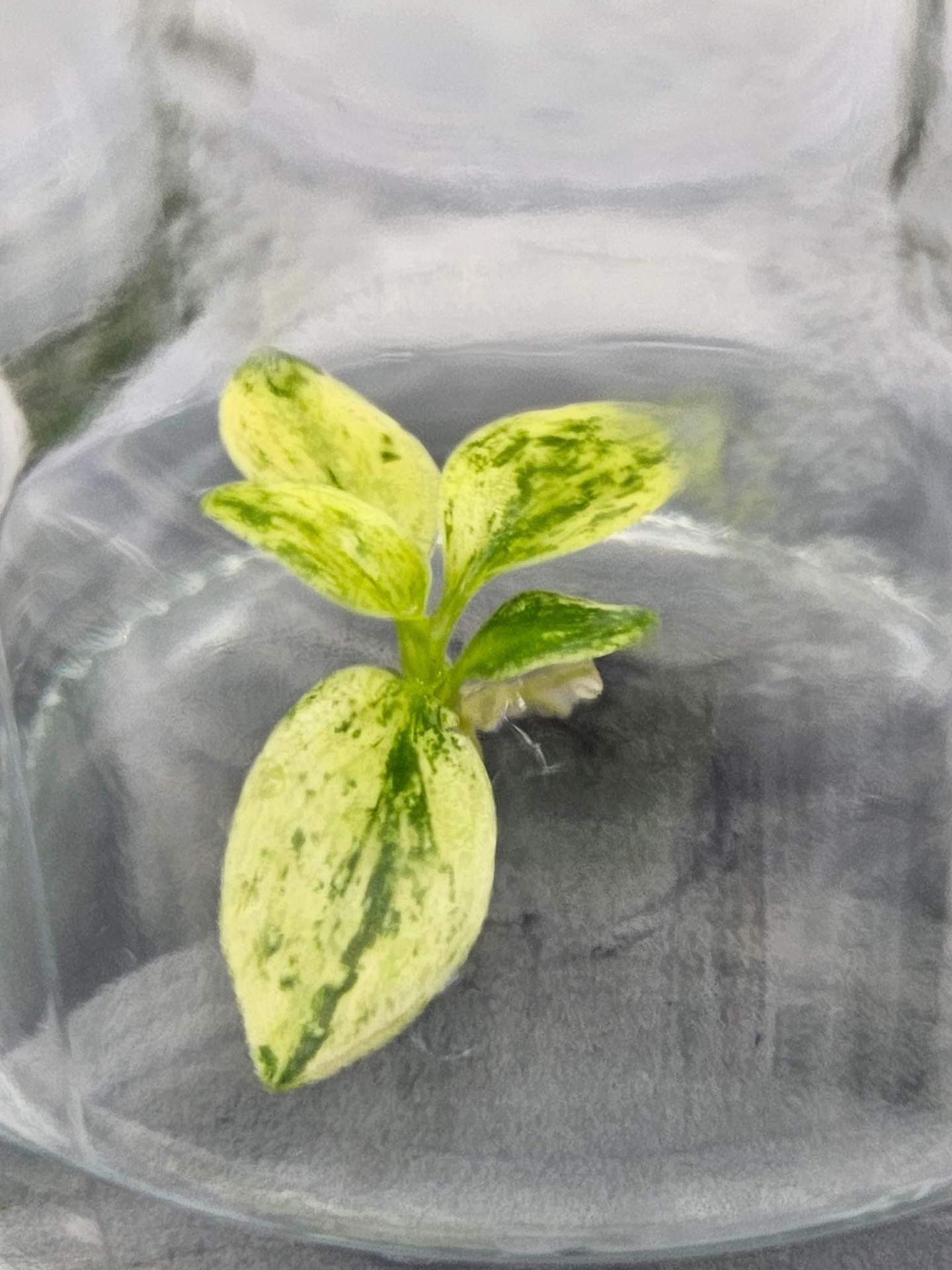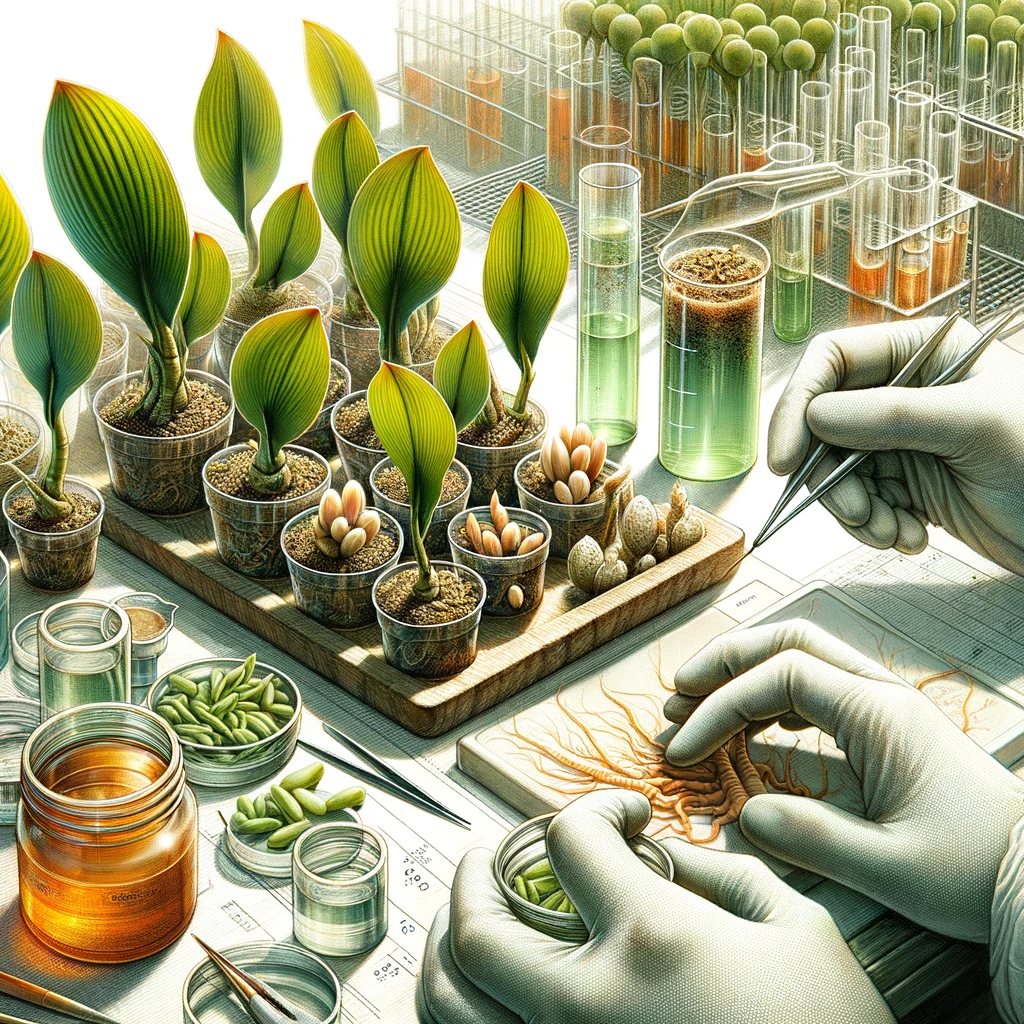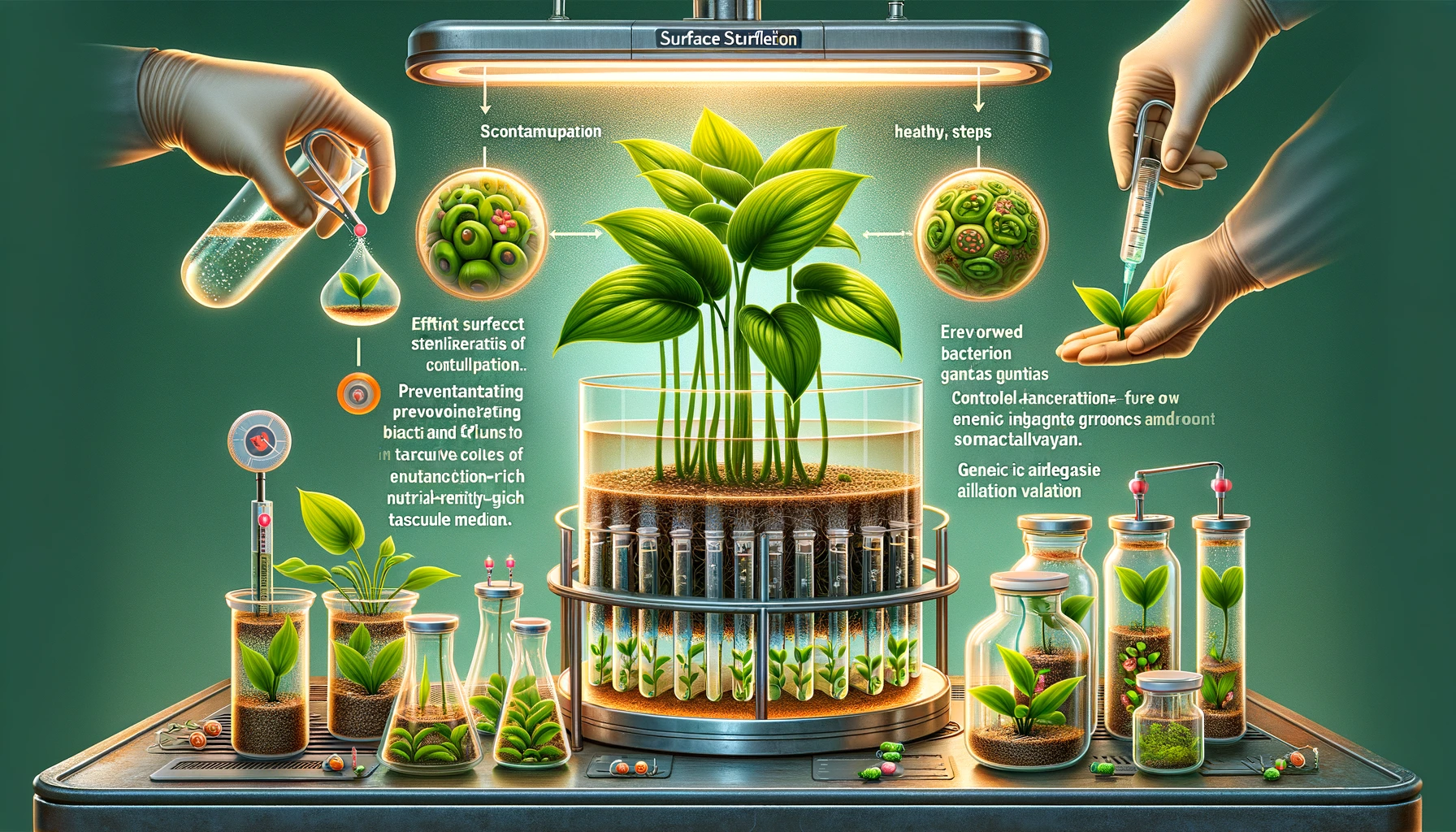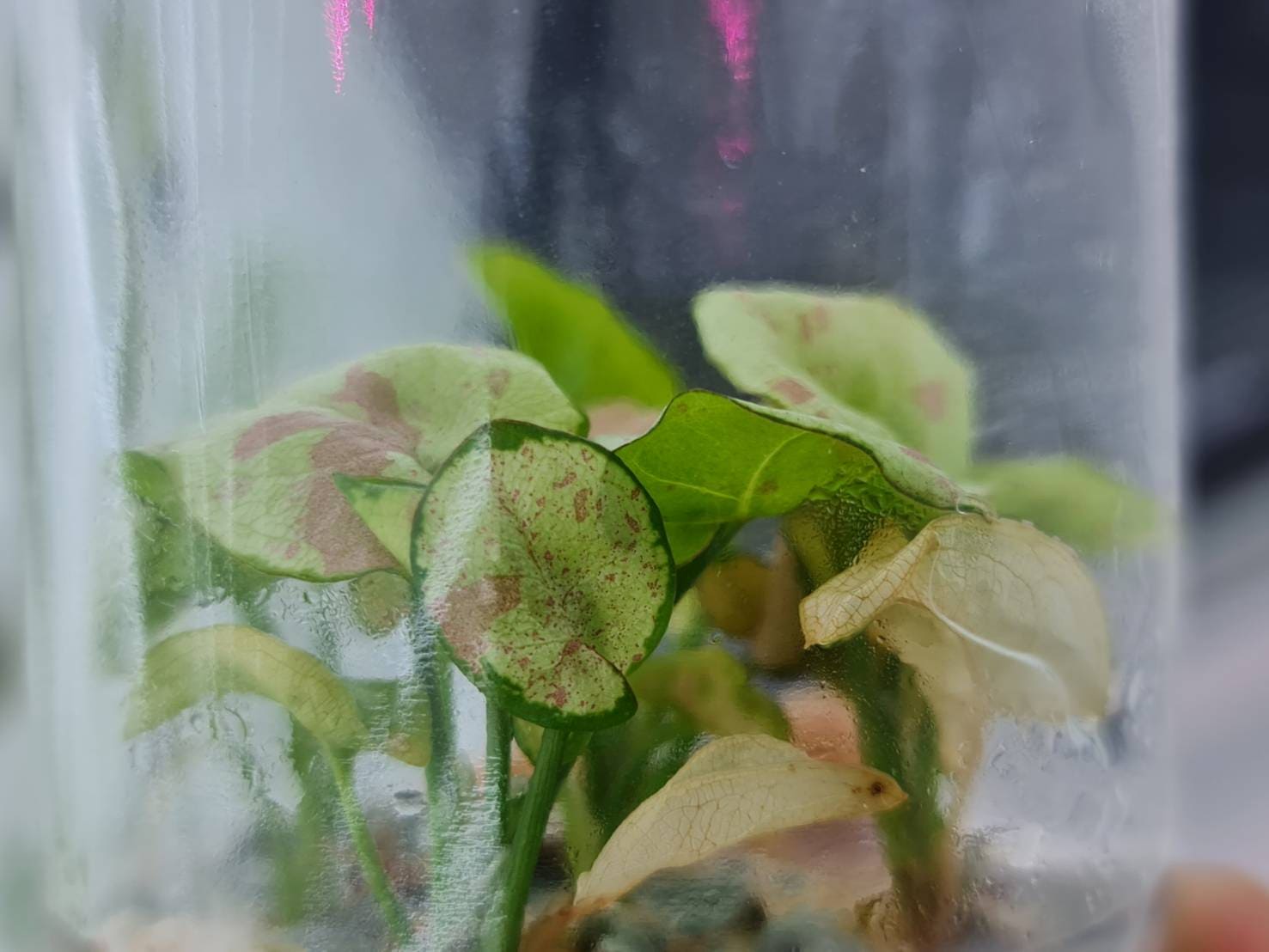Aroid plants, with their striking foliage and diverse forms, have captivated plant enthusiasts for generations. These members of the Araceae family, including popular species like Monstera, Philodendron, and Anthurium, are prized for their ornamental value and adaptability. However, their propagation through traditional methods can be slow and inefficient. Tissue culture, a technique utilizing sterile conditions and plant cell culture to produce large numbers of identical plants, offers a faster and more controlled approach to aroid propagation. A fundamental step in aroid tissue culture is surface sterilization of explants, the small pieces of plant material used for initiating the culture. This sterilization process plays a critical role in eliminating the microorganisms present on the explant’s surface, preventing contamination and ensuring the successful establishment of the culture. Failure to adequately sterilize explants can lead to the growth of unwanted bacteria and fungi, jeopardizing the entire culture and hindering the development of healthy plantlets.

Surface Sterilization of Explants
The surface sterilization of explants is a crucial step in the tissue culture process for aroid plants. Explants, which are small segments of plant material used to initiate the culture, are often taken from various parts of the plant, such as leaves, stems, or roots. These explants can harbor a variety of microorganisms, including bacteria, fungi, and viruses, which can contaminate the culture and compromise its success.

Importance of Effective Sterilization
Effective surface sterilization of explants is essential for the following reasons:
- Preventing Contamination: Microorganisms present on the explant’s surface can quickly proliferate in the nutrient-rich tissue culture medium, leading to the growth of unwanted bacteria and fungi. This contamination can rapidly spread throughout the culture, compromising the entire process.
- Ensuring Healthy Plantlet Development: Contamination can inhibit the growth and development of the cultured explants, resulting in stunted or unhealthy plantlets. This can ultimately affect the quality and viability of the final plants produced through tissue culture.
- Maintaining Genetic Integrity: Uncontrolled microbial growth can lead to genetic instability and somaclonal variation, potentially altering the desired characteristics of the aroid plants being propagated.

Factors Affecting Sterilization Efficiency
The effectiveness of the surface sterilization process is influenced by several factors, including:
- Plant Species and Tissue Type: Different aroid species and the type of explant (e.g., leaf, stem, or root) may require different sterilization protocols due to variations in surface characteristics and microbial load.
- Microbial Contamination Level: The level of microbial contamination on the explant’s surface can vary depending on factors such as the plant’s growth environment, handling techniques, and the age and condition of the plant material.
- Sterilizing Agent Concentration and Exposure Time: The choice of sterilizing agent (e.g., bleach, ethanol, or mercury compounds) and its concentration, as well as the duration of exposure, can significantly impact the effectiveness of the sterilization process.
- Pretreatment and Washing Steps: Pre-treatments, such as rinsing the explants with water or detergent solutions, and thorough washing steps can help remove surface debris and enhance the penetration and effectiveness of the sterilizing agent.
Importance of Sterile Conditions in Tissue Culture
The importance of maintaining sterile conditions throughout the entire tissue culture process cannot be overstated. Tissue culture relies on the principle of aseptic technique, which aims to minimize contamination by microorganisms. This is crucial for two primary reasons:
- Successful Establishment of the Culture: Contamination by microorganisms can prevent the successful initiation and growth of the cultured explants. Unwanted microbial growth can outcompete the plant cells, leading to the failure of the entire culture.
- Maintenance of Genetic Integrity: Microbial contamination can introduce genetic instability and somaclonal variation, potentially altering the desired characteristics of the aroid plants being propagated. This can result in the production of undesirable or off-type plantlets.
To ensure sterile conditions throughout the tissue culture process, several measures are taken, including:
- Strict protocols for equipment and workspace sterilization
- Proper personal hygiene and use of protective gear (e.g., lab coats, gloves, and face masks) by the laboratory personnel
- Careful handling and manipulation of plant materials and culture media within a laminar flow cabinet or other sterile work environment
- Routine monitoring and testing for microbial contamination in the culture media and plantlets

Common Sterilization Techniques
To effectively sterilize aroid explants for tissue culture, a variety of sterilization techniques can be employed. The choice of technique depends on factors such as the plant species, the type of explant, and the level of microbial contamination. Here are some common sterilization techniques used in aroid tissue culture:
Chemical Sterilization
Chemical sterilization involves the use of various disinfecting agents to eliminate microorganisms from the surface of the explants. Some commonly used chemical sterilants include:
- Sodium Hypochlorite (Bleach): Sodium hypochlorite is a widely used disinfectant in tissue culture due to its broad-spectrum antimicrobial activity and relative affordability. Concentrations typically range from 0.5% to 3.0%, and exposure times can vary from a few minutes to up to 30 minutes, depending on the plant material and level of contamination.
- Ethanol: Ethanol, typically in concentrations ranging from 70% to 95%, is an effective sterilizing agent that can be used alone or in combination with other disinfectants. Ethanol is particularly useful for surface sterilization due to its ability to penetrate and disrupt microbial cell membranes.
- Mercuric Chloride (HgCl2): Mercuric chloride is a potent sterilizing agent that can be used for surface sterilization of aroid explants. However, due to its high toxicity, the use of mercuric chloride is less common, and alternative sterilization methods are often preferred.
- Hydrogen Peroxide (H2O2): Hydrogen peroxide is a powerful oxidizing agent that can effectively sterilize aroid explants. It is particularly useful for sensitive plant tissues that may not tolerate other stronger disinfectants.

Physical Sterilization
Physical sterilization methods rely on the application of various physical factors to eliminate microorganisms from the explant’s surface. These methods include:
- Heat Treatment: Exposing explants to high temperatures, such as flaming or autoclaving, can effectively kill microorganisms. However, this method should be used with caution, as excessive heat can damage or kill the plant tissue.
- Ultraviolet (UV) Irradiation: UV radiation, particularly in the range of 254-280 nm, can effectively inactivate microorganisms by damaging their DNA. UV sterilization can be an effective supplement to chemical sterilization methods.
- Cryogenic Treatment: Freezing explants in liquid nitrogen or other cryogenic agents can help eliminate certain types of microorganisms. This method is particularly useful for sterilizing hard-to-reach areas on the plant surface.
Combination Techniques
In many cases, a combination of chemical and physical sterilization methods is employed to achieve the most effective surface sterilization of aroid explants. For example, a pre-treatment with a mild chemical disinfectant, followed by a quick rinse and then exposure to UV radiation or heat, can enhance the overall sterilization efficiency.
Optimization and Validation
When establishing a surface sterilization protocol for aroid tissue culture, it is essential to optimize the process by carefully testing and validating the chosen techniques. This may involve experimenting with different concentrations of sterilizing agents, exposure times, and combinations of methods to determine the most effective and least damaging approach for the specific plant species and explant type.
Additionally, it is crucial to regularly monitor the effectiveness of the sterilization protocol by assessing the contamination rates in the established cultures. This ongoing validation ensures that the sterilization process remains robust and reliable, minimizing the risk of contamination and supporting the successful propagation of healthy aroid plantlets.
Conclusion
Surface sterilization of explants is a critical step in the tissue culture of aroid plants. Effective sterilization is essential for preventing microbial contamination, ensuring the successful establishment of the culture, and maintaining the genetic integrity of the propagated plantlets. By understanding the importance of sterile conditions, the factors affecting sterilization efficiency, and the various sterilization techniques available, researchers and growers can optimize their aroid tissue culture protocols and enhance the success of their propagation efforts.
FAQs
1. Why is sterilization crucial in aroid plant tissue culture?
Sterilization is essential to eliminate bacteria, fungi, and other microorganisms that can contaminate the tissue culture and hinder the growth of the aroid plant. Contamination can lead to the failure of the culture or produce unhealthy plants.
2. What are the common sterilization methods used for aroid explants?
Several methods are commonly used for aroid explant sterilization:
- Sodium hypochlorite (bleach): A diluted solution of bleach is a widely used surface sterilant.
- Ethanol: Used in concentrations of 70-95%, but caution is needed as it can be toxic to plant tissue.
- Hydrogen peroxide: A 3% solution is generally used.
- Mercuric chloride: While effective, it’s highly toxic and requires careful handling.
- Calcium hypochlorite: Available in powder form, it’s dissolved and filtered before use.
3. How long should I expose the aroid explant to the sterilant?
The exposure time varies depending on the sterilant and the type of explant. For example, sodium hypochlorite might be used for 10-20 minutes, while ethanol exposure should be very brief (1 second). Specific protocols should be followed for each method.
4. Can I use a combination of sterilants?
Yes, sequential sterilization using different sterilants can be more effective in eliminating a broader range of contaminants. A common practice is to use ethanol followed by sodium hypochlorite.
5. Are there any alternatives to chemical sterilization?
While chemical sterilization is the most common, other methods like using plant preservative mixture (PPM), antibiotics, or even physical methods like flame sterilization can be considered. However, these methods might have limitations or require specific expertise.
Ready to Dive into the World of Tissue Culture Aroids? Explore our curated collection of Tissue Culture Aroid Plants at Greenboog, where we’ve harnessed the power of science to bring you the most sought-after and rare varieties. From the vibrant variegation of Philodendrons to the striking foliage of Monsteras, our tissue-cultured plants are disease-free, robust, and ready to thrive in your collection. Discover the future of plant propagation and elevate your indoor jungle with Greenboog’s Tissue Culture Aroids.


